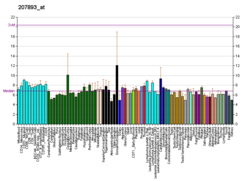|
| SRY |
|---|
 | | Estruturas disponíveis |
|---|
| PDB | Pesquisa Human UniProt: PDBe RCSB |
|---|
|
| | Identificadores |
|---|
| Nomes alternativos | SRY |
|---|
| IDs externos | OMIM: 480000 HomoloGene: 48168 GeneCards: SRY |
|---|
| Ontologia genética |
|---|
| Função molecular | • GO:0001131, GO:0001151, GO:0001130, GO:0001204 DNA-binding transcription factor activity
• transcription factor binding
• calmodulin binding
• transcription factor activity, RNA polymerase II distal enhancer sequence-specific binding
• DNA binding
• GO:0001200, GO:0001133, GO:0001201 DNA-binding transcription factor activity, RNA polymerase II-specific
• GO:0001948, GO:0016582 ligação a proteínas plasmáticas
• GO:0001077, GO:0001212, GO:0001213, GO:0001211, GO:0001205 DNA-binding transcription activator activity, RNA polymerase II-specific
|
|---|
| Componente celular | • citoplasma
• nuclear speck
• cariolinfa
• núcleo celular
|
|---|
| Processo biológico | • diferenciação celular
• GO:0009373 regulation of transcription, DNA-templated
• sex differentiation
• transcription, DNA-templated
• GO:0060469, GO:0009371 positive regulation of transcription, DNA-templated
• positive regulation of male gonad development
• male sex determination
• GO:0044324, GO:0003256, GO:1901213, GO:0046019, GO:0046020, GO:1900094, GO:0061216, GO:0060994, GO:1902064, GO:0003258, GO:0072212 regulation of transcription by RNA polymerase II
• GO:1901227 negative regulation of transcription by RNA polymerase II
• GO:0003257, GO:0010735, GO:1901228, GO:1900622, GO:1904488 positive regulation of transcription by RNA polymerase II
• central nervous system development
• GO:1901313 positive regulation of gene expression
• diferenciação neural
|
|---|
| Sources:Amigo / QuickGO |
| | | | Wikidata | |
O gene SRY (do inglês sex-determining region Y) é a região do cromossomo Y que determina o desenvolvimento dos genitais masculinos nos mamíferos térios (marsupiais e placentários).[2]
Alterações genéticas
Mutações nesse gene são a causa de diversos de distúrbios relacionados ao desenvolvimento dos genitais e das características sexuais masculinas como[3]:
- Síndrome de insensibilidade a andrógenos: pode ser causada por defeito na parte desse gene responsável pelos receptores de andrógenos (como a testosterona). Se nenhum receptor a andrógenos funciona uma pessoa com XY terá a aparência e genitais femininos.[4]
- Síndrome do homem XX: Quando o SRY foi translocado para o cromossomo X ou foi deletado ou está defeituoso no cromossomo Y. Se o SRY está ausente a síndrome foi causada pelos outros genes que também regulam o desenvolvimento sexual.
- Síndrome da mulher XY: Quando SRY está ausente ou defeituoso no cromossomo Y. Quando o SRY está intacto pode ser causado por factores de inibição da expressão desse gene.
Determinação sexual
O SRY não é o único gene responsável pela Determinação sexual cromossômica em mamíferos, outros genes produzem proteínas que regulam seu funcionamento como o Factor esteroidogênico 1 (SF1), o fator de transcrição da proteína de especificidade 1 e a proteína do tumor de Wilms 1 (WT1). [5]
Patologias
O SRY também foi associado ao fato de que os homens são mais propensos do que as mulheres a desenvolver doenças relacionadas a produção de dopamina como esquizofrenia e doença de Parkinson. O SRY codifica uma proteína que controlam a concentração de dopamina, o neurotransmissor que transporta sinais do cérebro que controlam o movimento, a coordenação motora e o prazer.[6]
Referências
- ↑ «Human PubMed Reference:»
- ↑ Wallis MC, Waters PD, Graves JA (2008). «Sex determination in mammals - Before and after the evolution of SRY». Cell. Mol. Life Sci. 65 (20). 3182 páginas. PMID 18581056. doi:10.1007/s00018-008-8109-z
- ↑ Margarit E, Coll MD, Oliva R, Gómez D, Soler A, Ballesta F (January 2000). "SRY gene transferred to the long arm of the X chromosome in a Y-positive XX true hermaphrodite". Am. J. Med. Genet. 90 (1): 25–8. doi:10.1002/(SICI)1096-8628(20000103)90:1<25::AID-AJMG5>3.0.CO;2-5
- ↑ Yuan X, Lu ML, Li T, Balk SP (December 2001). "SRY interacts with and negatively regulates androgen receptor transcriptional activity". J. Biol. Chem. 276 (49): 46647–54. doi:10.1074/jbc.M108404200
- ↑ Ely D, Underwood A, Dunphy G, Boehme S, Turner M, Milsted A (November 2010). "Review of the Y chromosome, Sry and hypertension". Steroids. 75 (11): 747–53. doi:10.1016/j.steroids.2009.10.015
- ↑ Dewing P, Chiang CW, Sinchak K, Sim H, Fernagut PO, Kelly S, Chesselet MF, Micevych PE, Albrecht KH, Harley VR, Vilain E (February 2006). "Direct regulation of adult brain function by the male-specific factor SRY". Curr. Biol. 16 (4): 415–20. doi:10.1016/j.cub.2006.01.017
Leitura de apoio
- Haqq CM, King CY, Ukiyama E; et al. (1995). «Molecular basis of mammalian sexual determination: activation of Müllerian inhibiting substance gene expression by SRY.». Science. 266 (5190): 1494–500. PMID 7985018. doi:10.1126/science.7985018
- Goodfellow PN, Lovell-Badge R (1994). «SRY and sex determination in mammals.». Annu. Rev. Genet. 27: 71–92. PMID 8122913. doi:10.1146/annurev.ge.27.120193.000443
- Hawkins JR (1994). «Mutational analysis of SRY in XY females.». Hum. Mutat. 2 (5): 347–50. PMID 8257986. doi:10.1002/humu.1380020504
- Harley VR (2002). «The molecular action of testis-determining factors SRY and SOX9.». Novartis Found. Symp. 244: 57–66; discussion 66–7, 79–85, 253–7. PMID 11990798. doi:10.1002/0470868732.ch6
- Jordan BK, Vilain E (2003). «Sry and the genetics of sex determination.». Adv. Exp. Med. Biol. 511: 1–13; discussion 13–4. PMID 12575752
- Oh HJ, Lau YF (2006). «KRAB: a partner for SRY action on chromatin.». Mol. Cell. Endocrinol. 247 (1-2): 47–52. PMID 16414182. doi:10.1016/j.mce.2005.12.011
- Polanco JC, Koopman P (2007). «Sry and the hesitant beginnings of male development.». Dev. Biol. 302 (1): 13–24. PMID 16996051. doi:10.1016/j.ydbio.2006.08.049
- Hawkins JR, Taylor A, Berta P; et al. (1992). «Mutational analysis of SRY: nonsense and missense mutations in XY sex reversal.». Hum. Genet. 88 (4): 471–4. PMID 1339396. doi:10.1007/BF00215684
- Hawkins JR, Taylor A, Goodfellow PN; et al. (1992). «Evidence for increased prevalence of SRY mutations in XY females with complete rather than partial gonadal dysgenesis.». Am. J. Hum. Genet. 51 (5): 979–84. PMC 1682856
 . PMID 1415266 . PMID 1415266
- Ferrari S, Harley VR, Pontiggia A; et al. (1992). «SRY, like HMG1, recognizes sharp angles in DNA.». EMBO J. 11 (12): 4497–506. PMC 557025
 . PMID 1425584 . PMID 1425584
- Jäger RJ, Harley VR, Pfeiffer RA; et al. (1993). «A familial mutation in the testis-determining gene SRY shared by both sexes.». Hum. Genet. 90 (4): 350–5. PMID 1483689
- Vilain E, McElreavey K, Jaubert F; et al. (1992). «Familial case with sequence variant in the testis-determining region associated with two sex phenotypes.». Am. J. Hum. Genet. 50 (5): 1008–11. PMC 1682588
 . PMID 1570829 . PMID 1570829
- Müller J, Schwartz M, Skakkebaek NE (1992). «Analysis of the sex-determining region of the Y chromosome (SRY) in sex reversed patients: point-mutation in SRY causing sex-reversion in a 46,XY female.». J. Clin. Endocrinol. Metab. 75 (1): 331–3. PMID 1619028. doi:10.1210/jc.75.1.331
- McElreavey KD, Vilain E, Boucekkine C; et al. (1992). «XY sex reversal associated with a nonsense mutation in SRY.». Genomics. 13 (3): 838–40. PMID 1639410. doi:10.1016/0888-7543(92)90164-N
- Sinclair AH, Berta P, Palmer MS; et al. (1990). «A gene from the human sex-determining region encodes a protein with homology to a conserved DNA-binding motif.». Nature. 346 (6281): 240–4. PMID 1695712. doi:10.1038/346240a0
- Berkovitz GD, Fechner PY, Zacur HW; et al. (1991). «Clinical and pathologic spectrum of 46,XY gonadal dysgenesis: its relevance to the understanding of sex differentiation.». Medicine (Baltimore). 70 (6): 375–83. PMID 1956279
- Berta P, Hawkins JR, Sinclair AH; et al. (1991). «Genetic evidence equating SRY and the testis-determining factor.». Nature. 348 (6300): 448–50. PMID 2247149. doi:10.1038/348448A0
- Jäger RJ, Anvret M, Hall K, Scherer G (1991). «A human XY female with a frame shift mutation in the candidate testis-determining gene SRY.». Nature. 348 (6300): 452–4. PMID 2247151. doi:10.1038/348452a0
- Ellis NA, Goodfellow PJ, Pym B; et al. (1989). «The pseudoautosomal boundary in man is defined by an Alu repeat sequence inserted on the Y chromosome.». Nature. 337 (6202): 81–4. PMID 2909893. doi:10.1038/337081a0
- Whitfield LS, Hawkins TL, Goodfellow PN, Sulston J (1995). «41 kilobases of analyzed sequence from the pseudoautosomal and sex-determining regions of the short arm of the human Y chromosome.». Genomics. 27 (2): 306–11. PMID 7557997. doi:10.1006/geno.1995.1047
|

